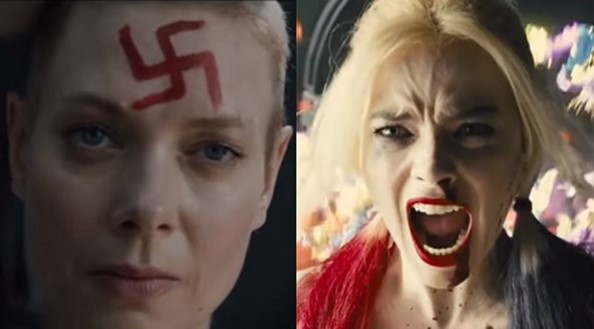Movies talk to each other. What did the films of 2021 have to say? This is a look at how two movies from the past year tackle similar subjects in different ways. Be warned, SPOILERS for The Suicide Squad and Hell Hath No Fury follow.
Are we really in 2022? Did we skip a few years? Because it’s 2019 all over again, I watched a Jesse V. Johnson direct-to-video flick beat a reiteration of a reiteration of a big action franchise at its own game, just like a few years ago. Maybe it’s part of this endless pandemic and its relaxations and variant lockdowns. We’re running in place as we pretend to go forward, unable to face the consequences and move past where we’ve been.
At the start of Hell Hath No Fury, Nina Bergman’s Marie is living the consequences of her past. She just got out of a horrible Nazi prison in spring 1944, her fellow French countrymen are shaving her head for being a collaborator and worse is clearly intended until a foursome of Americans whisk her away. Those troops know her past too, that she was shacking up with a Nazi and knows where his gold is buried in an old cemetery a little ways out of town. Her rescue will be paid for and some of the Greatest Generation will get a little richer – except there are a few Resistance fighters also hanging out at the cemetery, and that Nazi is on his way with a platoon of goons.
Much like Johnson’s previous film Avengement, Hell Hath No Fury toggles between the bloody present and what led to this state. Katherine Lee McEwan’s screenplay reveals backstory in pieces and lets people make decisions based on incomplete information. The movie opens with a flashback of Marie pleading with Resistance fighters to let her go, that she’s actually one of them, before her Nazi beau Von Bruckner kills them all. Her allegiance is unclear for much of the movie. Was she really a Nazi? Was she going along with them just to survive? Does that matter?
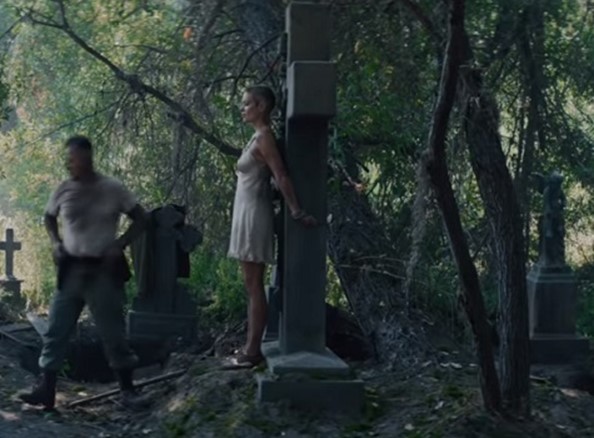
The Americans who abduct/rescue her are clearer in their motivations – they’re in it for the money. Led by Major Maitland (played by Louis Mandylor with a Southern accent that he can’t quite wrangle, fortunately his Charles Bronson-meets-Rodney-Dangerfield face carries the character), they are crude and have no illusions about their role in this war against evil. They’re meat to be thrown into the machine, people made to kill for years and about to be dumped back in a country that won’t want those skills, no sir. So they see a chance to cash out and the one guy who has some qualms about all this is quickly killed by one of those Resistance fighters, who’s carrying a torch for Marie.
Marie is no fool and knows that her value is tied to her knowledge – give that up, and why should she be kept around? She points the Americans to various places around the cemetery to dig for that gold, and of course there is nothing there, nothing more than the minutes it takes for the men to dig and the extra minutes Marie remains alive. Maitland finally tires of this and forces her hand. He places the skulls that his men have dug up on Marie’s head and shoots them off, William Tell-style, until Marie breaks. It’s a great, grim visual: Marie, alive and quaking, under a premonition of the corpse she is desperately trying to avoid becoming. Maitland shoots and steps back another few yards and shoots again. What is the calculus here? When does what you do to stay alive cross over into killing you? Or into making you into something you can’t live with the consequences of being?
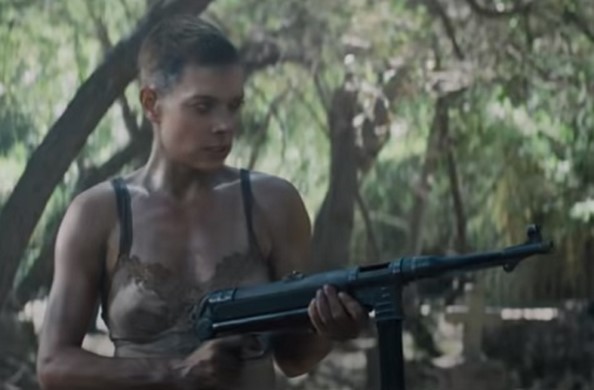
For the Suicide Squad, which existed as a concept for a while but was fully organized and developed by comics writer John Ostrander, that line is a blur. The concept is simple and brilliant: A bunch of degenerates, at some point captured by the government, are forced to go out on secret black ops missions and handle the work that can’t be given to regular soldiers like those grunts in Hell Hath No Fury. The missions are dangerous if not almost certainly deadly, which points to the roots of the concept in The Dirty Dozen. But because this is a comic book, the degenerates generally have superpowers, and they are kept in line by bombs implanted in their heads, which will go off if they go off mission. It’s possible to thread that needle between dying in the field or dying because merciless government honcho Amanda Waller pushes a button, but most people don’t.
As a set-up, this would seem impossible to fuck up. And yet! David Ayer’s 2016 film Suicide Squad was flaming garbage, in part because it was drastically recut, but also because it was made by cowards who couldn’t meet the ruthless standards set by a PG cartoon and who couldn’t understand that these people are not friends. Comrades of circumstance, perhaps, but not the “family” they claim to be at the end, relying on each other. Because comic book movies are not allowed to fail and because certain parts of Ayer’s movie – most importantly Margot Robie’s Harley Quinn – were popular, James Gunn jumped ship from Marvel to, as the narrative went, finally go hard R.
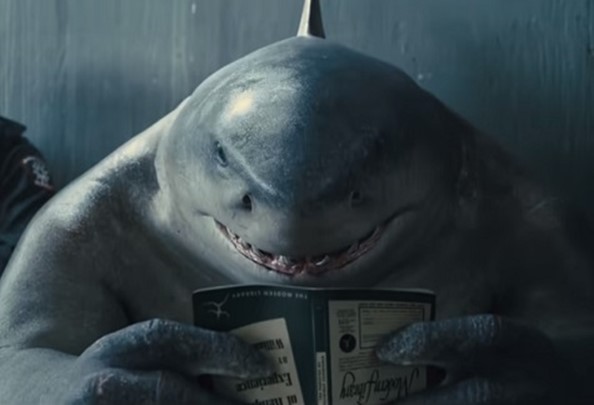
James Gunn, the Troma veteran, a guy who is not afraid of gore! And credit to Gunn, he makes the best comic book movie in ages – when he’s making a comic book movie. The plot of this 2+ hour movie – in which the Squad is told to invade a country and destroy a weapon of mass destruction now under the control of a US-unfriendly junta – ultimately reveals that WMD to be Starro, a giant alien starfish with a huge fucking eyeball in his torso. Starro stomps all over the place and unleashes thousands of mini-starfish to stick to people’s faces and mind-control them into causing even more havok. There is body horror and destruction and real unwinking commitment to a giant alien starfish as a menace, and that is pretty cool. But that is not what the movie is about. It, too, is about people coming together as friends, if not quite family.
Gunn wants viewers to “care” about the people of his Suicide Squad, not in the sense of being interested in what they do and what results from that, but to like and sympathize with them. The Squad murders a bunch of innocent people for laughs, slaughtering a bunch of freedom fighters because they thought they were commandos, and it’s supposed to be a gotcha moment for the audience, but the focus of the scene is the carnage and how the Squad feels sort of remorseful afterward. This is well within the standard blockbuster norm, where the point of the death of others is to make the heroes feel bad. Some of them do feel bad, or feel bad at the incredibly shocking revelation that a shadowy U.S. intelligence agency has lied to them, but they get the chance to be heroic and appreciated by everyone watching their actions on TV.
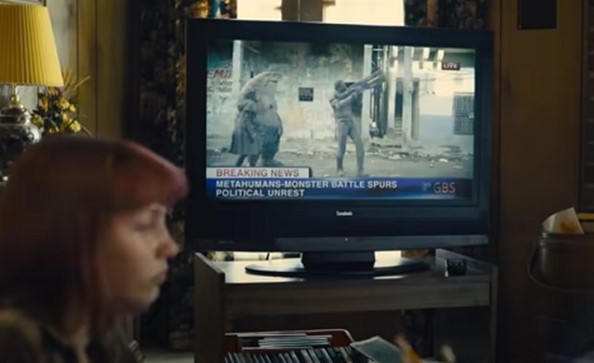
The people that don’t feel bad, and who have a “bad” philosophy of U.S. imperialism and containment, get righteously killed and beaten up. Consequences flow not from actions but feelings, generating a climax meant to be rousing and instead is empty. I can’t improve on beloved Soluter Drunk Napoleon’s summary of the movie: “The exact same arc as The Avengers with a filthier aesthetic.” But the simplistic, do-goodery plot of The Avengers is reflected in its aesthetics, its whiz-bang PG-13 violence. It’s not sophisticated but it’s not a fraud; The Suicide Squad hedges its edgy style with a reassurance that even these villains can be good.
Hell Hath No Fury doesn’t go full Cross of Iron and make a Nazi its protagonist, it finally reveals that Marie really was working for the resistance and that she really does know which tomb the gold is stashed in. Gold that was taken from Marie’s family and other Jews by Von Bruckner, who pulled a Hans Landa on her parents. After Von Bruckner killed those Resistance fighters in the prologue, Marie shot him and left him for dead, a righteous action as vengeance for killing her family. And one that didn’t stop her from getting caught immediately afterward and sent to that hellish prison, didn’t stop her from being branded as a traitor. Actions have consequences and consequences don’t have to follow your reasons or emotions. Even a person who thinks they’re good can wind up surrounded by corpses, partnered with questionable allies and facing almost certain death from an army of evil men.
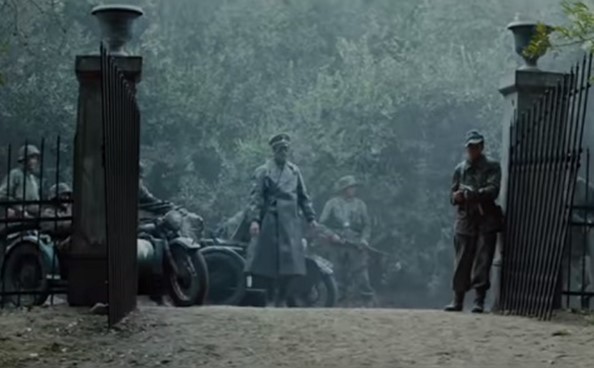
Marie, that lovelorn Resistance fighter and the two surviving Americans form a squad that is not facing the suicide of orders from above or the kinship of bonds from within. They all made choices to get where they end up and they make the choice to fight together because it’s the only way to survive. The final battle is grim and small-scale, taking place away from any witnesses and facing the coming obliteration of American bombers called in to blow up the cemetery from above. Lots of Nazis get owned and that rules, and when finally only Marie, Maitland and Von Bruckner are left, Maitland and Von Bruckner in a standoff. Maitland tells Marie to take out Von Bruckner so they can get the gold and get out of here, and she immediately shoots – Maitland. Just blows his ass away, he dies without another word. This encourages Von Bruckner, who gets close enough to Marie so she can stab him in the back and then crawl under his bleeding corpse for shelter from those incoming bombs. Because she’s made a final choice – no one is getting that gold, and she is going to walk away.
In 2019’s Avengement, Johnson doesn’t stint on showing protagonist Cain Burgess kicking the shit out of people but he also shows violence against Burgess – stabbings, burnings, the teeth curb-stomped right out of his head. Marie takes her share of knocks and does so in a thin slip of a dress. This doesn’t make her sexy but underlines how vulnerable she is in the graveyard’s mud as the bullets fly. And Bergman’s performance does not deny that vulnerability, it moves beyond it. She knows that no one else is going to help her, not really, and whatever limitations she has, she’s all she’s got. She comes out the other side not because she’s right or righteous, and not because the other people she dealt with wanted to live less than she did. She did what she had to do. And she does walk away, the movie ends with onscreen text saying she moved abroad and had a family and lived well and never again returned to the cemetery she escaped from with nothing but her life.
The Suicide Squad ends with the survivors being taken back, presumably for more adventures. There’s always something else to destroy the world and always more money to be made off that. This movie is a sequel itself of course, a follow-up is likely on the way, and one of the characters who appeared to have died in this movie is already back for a TV series. Coming back from death is an established comic book tradition of course but action is now entirely divorced from consequence. Maybe it’s easy to live with yourself when everything happens over and over again and nothing changes. That’s one way to beat dying, to always have another tomorrow.

